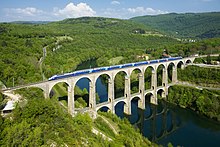Railway bridge
A railway bridge is a bridge , which has been specially constructed to a railway line and the trains running on their trains to run over obstacles.
The railway bridge is regularly used solely for train traffic, but it often also has a pedestrian or pedestrian path and cycle path. Combined railway and road bridges , which in turn are often designed as double-decker bridges , are less common.
conditions
Have railway bridges meet certain requirements: You must for high axle loads and high-speed lines are sized for high speeds; in Germany for new buildings or renewals for axles with loads of 25 t and for vehicle weights of 8 t / m per unit length and for speeds of up to 300 km / h on new lines . The high number of load cycles resulting from the rapid succession of the wheels must be taken into account in order to achieve a construction that is as fatigue-resistant as possible. There should be little acceleration forces acting on the passengers, which can occur when driving through hilltops or troughs when the loads of the train lead to changes in the shape of the bridge structure. Horizontal bend angles at the ends of the bridge superstructure and accelerations from curved tracks acting across the direction of travel should also be avoided.
The starting and braking loads of a train and their effect in the direction of shifting the structure must be taken into account.
The bridge deck must provide the same rail route as on the line, i.e. H. Tracks on a continuous ballast bed or a slab track , with a transition structure with rail extension devices to compensate for temperature- related changes in length of the bridge. The bridge must provide the same clearance profile as on the route and the same equipment with overhead lines , ladders for the liner control and other communications and electricity connections. The devices for maintaining the line must also be usable on the bridge. In addition, bridge inspection vehicles must be able to fully inspect the structure either from the terrain below or from the bridge.
General requirements are the uninterrupted availability of the bridge and low expenditure for inspection and maintenance. Repairs and replacement buildings should be inexpensive and also to be carried out under the rolling wheel . Ultimately, the trains crossing the bridge should emit the least possible noise.
Railway bridges in Germany
At the end of 2019 there were 25,707 bridges in the Deutsche Bahn network. The bridges are on average more than 70 years old. Around 12,000 are more than a hundred years old and more than 1,000 are ready for demolition. The service life of a DB railway bridge is an average of 122 years. The cost of planning and building railway bridges doubled between 2016 and 2018.
Web links
- Germany's railway bridges . Bridge portal of Deutsche Bahn, including information on all DB railway bridges.
literature
- Hans Pottgießer: Railway bridges from two centuries . Birkhäuser Verlag, Basel / Boston / Stuttgart 1985, ISBN 3-7643-1677-2 (320 pages).
Individual evidence
- ↑ The information is based on: Rolf H. Pfeifer, Tristan M. Mölter: Handbuch Eisenbahnbrücken. Eurailpress, Hamburg 2008, ISBN 978-3-7771-0378-5
- ↑ § 8 EBO
- ↑ Infrastructure status and development report 2019. (PDF) Performance and financing agreement II. In: eba.bund.de. Deutsche Bahn, April 2020, p. 128 , accessed on May 17, 2020 .
- ↑ Thomas Wüpper: Dilapidated railway bridges burden Pofalla . In: Stuttgarter Nachrichten . tape 75 , January 8, 2020 ( online ).


